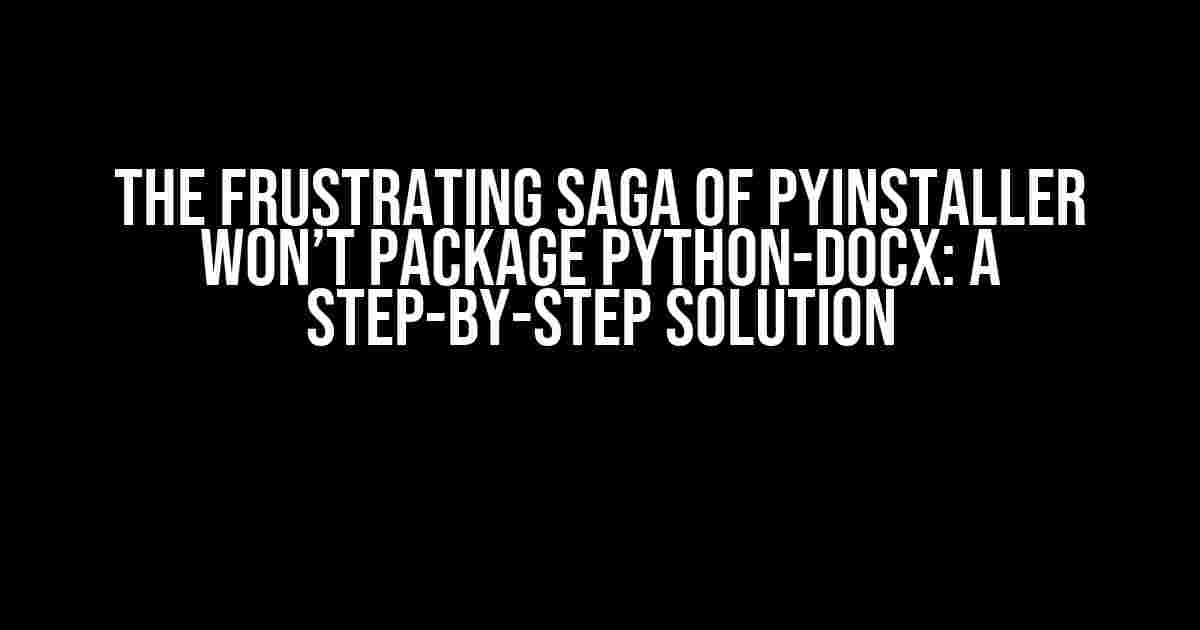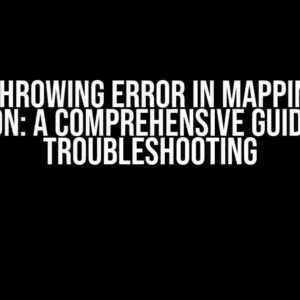Are you tired of banging your head against the wall, trying to figure out why PyInstaller won’t package Python-Docx? You’re not alone! This pesky issue has plagued many a developer, leaving them frustrated and stuck. But fear not, dear reader, for today we’ll embark on a journey to conquer this problem once and for all.
The Problem: PyInstaller Won’t Package Python-Docx
PyInstaller is a fantastic tool for packaging Python applications into standalone executables. Python-Docx, on the other hand, is a powerful library for working with Microsoft Word files in Python. When you try to combine these two, you’d expect a match made in heaven. Unfortunately, that’s not always the case.
The issue arises when PyInstaller fails to correctly package Python-Docx and its dependencies, resulting in a cryptic error message that leaves you scratching your head. But don’t worry, we’ll get to the bottom of this!
Why Does PyInstaller Won’t Package Python-Docx?
Before we dive into the solution, it’s essential to understand the root cause of the problem. There are a few reasons why PyInstaller won’t package Python-Docx:
- Python-Docx relies on external libraries, such as lxml and pillow, which PyInstaller struggles to include.
- The Python-Docx package has some quirks that make it difficult for PyInstaller to correctly identify and include all required modules.
- PyInstaller might not be configured correctly, leading to issues with packaging.
The Solution: A Step-by-Step Guide
Don’t worry, we’re about to turn this frustration into a piece of cake! Follow these instructions carefully, and you’ll be packaging Python-Docx like a pro in no time:
Step 1: Install Required Libraries
Make sure you have the following libraries installed:
pip install pyinstaller python-docx lxml pillowStep 2: Create a Script to Test Python-Docx
Create a new Python script, e.g., `docx_test.py`, with the following content:
import docx
doc = docx.Document()
doc.add_paragraph('Hello, World!')
doc.save('test.docx')Step 3: Configure PyInstaller
Create a new file, e.g., `pyinstaller.config`, with the following content:
[hiddenimports]
lxml
PIL
[Analysis]
imports=lxml,PILThis configuration tells PyInstaller to include the lxml and pillow libraries, which are essential for Python-Docx.
Step 4: Package the Script with PyInstaller
Run the following command to package your script:
pyinstaller --onefile --configfile=pyinstaller.config docx_test.pyThis command tells PyInstaller to create a standalone executable from your script, using the configuration file we created earlier.
Step 5: Verify the Package
After PyInstaller finishes running, you should see a new executable file, e.g., `docx_test`. Run this executable to verify that it works correctly:
./dist/docx_testIf everything went smoothly, you should see a new file, `test.docx`, created in the same directory.
Troubleshooting Common Issues
If you’re still encountering issues, don’t worry! Here are some common problems and their solutions:
| Issue | Solution |
|---|---|
| Error: “Failed to execute script docx_test” | Check that your Python script is correct and that the `pyinstaller.config` file is in the same directory as your script. |
| Error: “ImportError: No module named ‘lxml'” | Verify that you have installed the lxml library correctly and that it’s included in your `pyinstaller.config` file. |
| Error: “PILLOW_NOT_INSTALLED” | Make sure you have installed the pillow library correctly and that it’s included in your `pyinstaller.config` file. |
Conclusion
Voilà! With these steps, you should now be able to package Python-Docx using PyInstaller without any issues. Remember to carefully follow the instructions and troubleshoot any problems that arise.
By understanding the root cause of the problem and following this step-by-step guide, you’ll be able to create standalone executables that include Python-Docx, freeing you to focus on more important tasks.
Happy packaging, and may the forces of Python be with you!
Here are 5 FAQs about “pyinstaller won’t package python-docx” with a creative voice and tone:
Frequently Asked Question
Got stuck with pyinstaller and python-docx? Don’t worry, we’ve got you covered!
Why does pyinstaller refuse to package python-docx?
Pyinstaller has some trouble with python-docx because of its complex dependencies and usage of relative imports. This means pyinstaller can’t automatically detect all the necessary files, leading to a packaging fail.
How can I force pyinstaller to include python-docx?
You can use the `–hidden-import` option with pyinstaller to explicitly include python-docx. For example: `pyinstaller –hidden-import docx my_script.py`. This tells pyinstaller to package python-docx even if it’s not automatically detected.
What if I still get an error after using –hidden-import?
Sometimes, pyinstaller needs a little extra help. Try using the `–additional-hooks-dir` option to specify a directory where pyinstaller can find additional hooks for python-docx. You can also try excluding unnecessary dependencies or using a virtual environment to isolate your project’s dependencies.
Can I use a spec file to customize pyinstaller’s behavior?
Absolutely! A spec file allows you to customize pyinstaller’s behavior and specify exactly which files and dependencies to include. You can use the `–specpath` option to specify a custom spec file for your project. This is especially useful when working with complex dependencies like python-docx.
What if none of these solutions work for me?
Don’t worry, we’ve all been there! If none of these solutions work for you, try searching for specific error messages or issues related to your project. You can also try upgrading pyinstaller or python-docx to the latest versions. And if all else fails, you can always ask for help on online forums or communities like Stack Overflow or Reddit’s r/learnpython.



